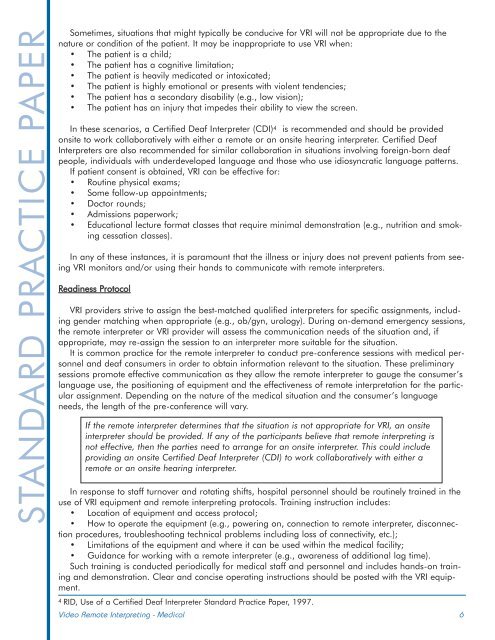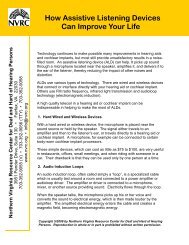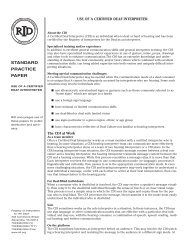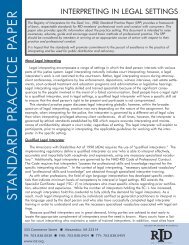Video Remote Interpreting Standard Practice Paper - Registry of ...
Video Remote Interpreting Standard Practice Paper - Registry of ...
Video Remote Interpreting Standard Practice Paper - Registry of ...
Create successful ePaper yourself
Turn your PDF publications into a flip-book with our unique Google optimized e-Paper software.
STANDARD PRACTICE PAPER<br />
Sometimes, situations that might typically be conducive for VRI will not be appropriate due to the<br />
nature or condition <strong>of</strong> the patient. It may be inappropriate to use VRI when:<br />
• The patient is a child;<br />
• The patient has a cognitive limitation;<br />
• The patient is heavily medicated or intoxicated;<br />
• The patient is highly emotional or presents with violent tendencies;<br />
• The patient has a secondary disability (e.g., low vision);<br />
• The patient has an injury that impedes their ability to view the screen.<br />
In these scenarios, a Certified Deaf Interpreter (CDI) 4 is recommended and should be provided<br />
onsite to work collaboratively with either a remote or an onsite hearing interpreter. Certified Deaf<br />
Interpreters are also recommended for similar collaboration in situations involving foreign-born deaf<br />
people, individuals with underdeveloped language and those who use idiosyncratic language patterns.<br />
If patient consent is obtained, VRI can be effective for:<br />
• Routine physical exams;<br />
• Some follow-up appointments;<br />
• Doctor rounds;<br />
• Admissions paperwork;<br />
• Educational lecture format classes that require minimal demonstration (e.g., nutrition and smoking<br />
cessation classes).<br />
In any <strong>of</strong> these instances, it is paramount that the illness or injury does not prevent patients from seeing<br />
VRI monitors and/or using their hands to communicate with remote interpreters.<br />
Readiness Protocol<br />
VRI providers strive to assign the best-matched qualified interpreters for specific assignments, including<br />
gender matching when appropriate (e.g., ob/gyn, urology). During on-demand emergency sessions,<br />
the remote interpreter or VRI provider will assess the communication needs <strong>of</strong> the situation and, if<br />
appropriate, may re-assign the session to an interpreter more suitable for the situation.<br />
It is common practice for the remote interpreter to conduct pre-conference sessions with medical personnel<br />
and deaf consumers in order to obtain information relevant to the situation. These preliminary<br />
sessions promote effective communication as they allow the remote interpreter to gauge the consumer’s<br />
language use, the positioning <strong>of</strong> equipment and the effectiveness <strong>of</strong> remote interpretation for the particular<br />
assignment. Depending on the nature <strong>of</strong> the medical situation and the consumer’s language<br />
needs, the length <strong>of</strong> the pre-conference will vary.<br />
If the remote interpreter determines that the situation is not appropriate for VRI, an onsite<br />
interpreter should be provided. If any <strong>of</strong> the participants believe that remote interpreting is<br />
not effective, then the parties need to arrange for an onsite interpreter. This could include<br />
providing an onsite Certified Deaf Interpreter (CDI) to work collaboratively with either a<br />
remote or an onsite hearing interpreter.<br />
In response to staff turnover and rotating shifts, hospital personnel should be routinely trained in the<br />
use <strong>of</strong> VRI equipment and remote interpreting protocols. Training instruction includes:<br />
• Location <strong>of</strong> equipment and access protocol;<br />
• How to operate the equipment (e.g., powering on, connection to remote interpreter, disconnection<br />
procedures, troubleshooting technical problems including loss <strong>of</strong> connectivity, etc.);<br />
• Limitations <strong>of</strong> the equipment and where it can be used within the medical facility;<br />
• Guidance for working with a remote interpreter (e.g., awareness <strong>of</strong> additional lag time).<br />
Such training is conducted periodically for medical staff and personnel and includes hands-on training<br />
and demonstration. Clear and concise operating instructions should be posted with the VRI equipment.<br />
4 RID, Use <strong>of</strong> a Certified Deaf Interpreter <strong>Standard</strong> <strong>Practice</strong> <strong>Paper</strong>, 1997.<br />
<strong>Video</strong> <strong>Remote</strong> <strong>Interpreting</strong> - Medical 6






